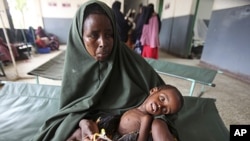United Nations and international aid agencies say the crisis in the Horn of Africa is overwhelming their ability to provide assistance to the millions of people suffering from the region's worst drought in 60 years. The agencies say they are overstretched and underfunded and are appealing for more help from the international community.
The drought crisis is affecting Ethiopia, Kenya, central and southern Somalia and Djibouti. But, aid agencies say the impact is greatest in Somalia. They say the fall in crop production is causing food prices to rise. Compounding this problem is the ongoing fighting between the government and al-Shabab insurgents.
The United Nations reports more than one-third of Somalia's 7.5 million inhabitants needs humanitarian assistance. Because of the prevailing insecurity, most aid agencies have left the country. Some still maintain a presence in the more peaceful parts and also provide assistance through local aid agencies.
Recently al-Shabab issued a statement inviting international agencies to return to Somalia. The U.N. refugee agency welcomes this statement. But, Chief UNHCR spokesperson, Melissa Fleming, says there needs to be guarantees of safety before staff can return.
"We go in as one U.N. - and I think the U.N. has been preparing for quite some time and has really seriously been wanting to go into South-Central Somalia in a bigger way. So, I think there has been a lot of contingency planning done and people braced to go in. We are already operating in Somalia, but much more needs to be done and we are ready to go in, in a much more robust and meaningful way," Fleming said.
While hundreds of thousands of victims of drought and conflict remain stuck inside Somalia, thousands more are fleeing to neighboring countries. The United Nations estimates 54,000 Somalis have crossed into Ethiopia since the beginning of the year. And, it notes some 1,400 Somali refugees are crossing into Kenya every day.
International agencies agree they are fighting an uphill battle trying to provide food, water, shelter and other basic needs to these thousands of destitute people.
The World Food Program (WFP) is currently feeding six million drought victims throughout the Horn of Africa. But, spokeswoman Emilia Casella says this number is expected to rise to 10 million.
"Malnutrition rates are particularly high among refugees from Somalia, especially children who have been crossing the border and we and our partners have seen rates of 45 percent …as the number arises, we are procuring and bringing in more kinds of highly fortified, supplementary food products, especially for the young children," noted Casella.
The U.N. Children's Fund estimates more than two million young children from the Horn of Africa are malnourished and in need of urgent life-saving actions. It says half a million of those children are facing imminent life-threatening conditions. It warns many may be left with long-lasting physical and mental problems.
Drought Crisis in Horn of Africa Overwhelming Aid Agencies
- By Lisa Schlein










